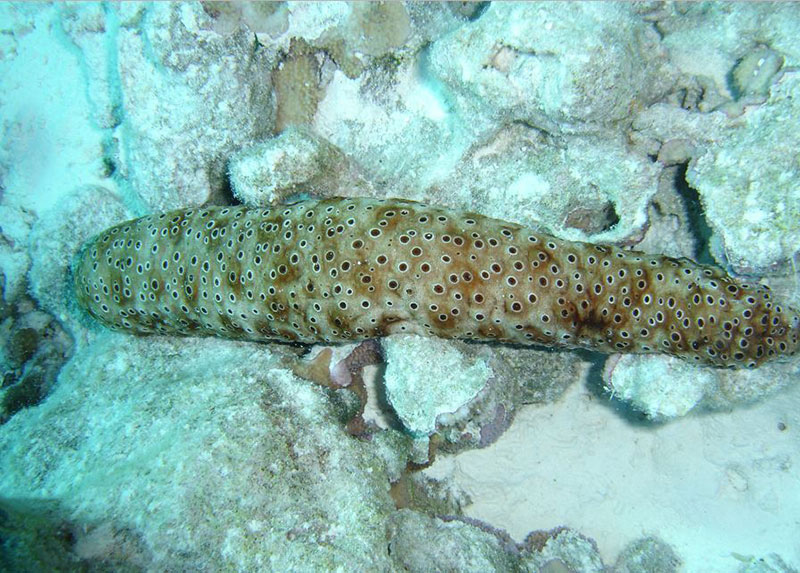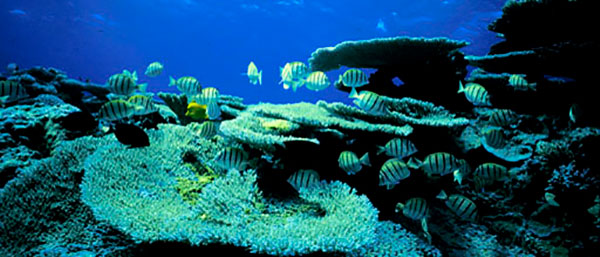
by Heidi Hirsh, Natural Resources Management Specialist NOAA Fisheries Service, Marine National Monuments Program
July 10, 2017

Chocolate chip sea cucumber (Holothuria sp.) at Johnston Atoll. Image courtesy of the Molly Timmers, NOAA. Download larger version (jpg, 471 KB).
The team is excited that, during this expedition, they will explore much of the never-before-seen deep-sea habitats of Johnston Atoll, and we look forward to learning of new discoveries, creatures, and features. But before we dive to the deep depths, let’s take a look at what we know about the shallow water ecosystems around the atoll.
The nearshore fisheries and corals off Johnston Atoll are said to be remarkably beautiful by those who have had the opportunity to snorkel or dive there. Johnston Atoll is completely isolated in the middle of the deep blue ocean and is a National Wildlife Refuge managed by the U.S. Fish and Wildlife Service and it was once home to military operations. Although the atoll had been occupied by the military from the 1930s until the early 2000s, the first oceanographic and marine biological studies were not initiated until 1983.

Left: Acropora cytherea is one of the major corals responsible for building the immense calcium carbonate substructure that supports the thin living skin of a reef. Right: Tightly packed branches and nariform (nose-shaped) corallites of Acropora nasuta resemble floral clusters. Images courtesy of the U.S. Fish and Wildlife Service. Download larger version (jpg, 104 KB).
The scientific surveys found the fish fauna to be comprised of a beautiful and colorful diversity of about 300 species. In contrast, there are about 536 species found in the Hawaiian Islands and about 844 species in the Mariana Islands. Johnston’s lower number of species may be due to the fact that it has fewer underwater habitat types than the Hawaiian and Marianas Islands.
The coral community is predominantly comprised of stony corals in the lagoon and outer reef slopes of the atoll, including yellow-lobed, plate, mushroom, cauliflower, finger, and staghorn corals. Compared with other tropical atolls, Johnston’s overall coral diversity, at 42 species, is low. However, the coral cover in the lagoon is “wall to wall” and dense, except where small patches of sand occur.
Interestingly, many of the species in the Papahānaumokuākea Marine National Monument originate from Johnston’s nearshore ecosystems, despite the two locations being separated by about 885 kilometers (548 miles) of water to French Frigate Shoals. Recent research involving a wide group of taxa suggests Johnston Atoll is a stepping stone to species colonization in the Hawaiian Archipelago.1 A genetics study of the Hawaiian grouper, biogeographic studies on corals of the genus Acropora, and genetics work on a species of snail (vermetid gastropods) have pointed to Johnston Atoll being a colonization pathway for these species.2

Convict tangs amidst a garden of coral heaven. Image courtesy of the U.S. Fish and Wildlife Service. Download larger version (jpg, 124 KB).
On the flip side, the currents also transport seeds and pelagic larvae from the Hawaiian Islands to Johnston Atoll. For example, kukui nuts have been found on Johnston’s beaches—the only known source of this nut in the North Pacific are the Hawaiian Islands, and the nuts on Johnston show clear signs of them having been adrift at sea.3 Also, populations of Acropora coral living at French Frigate Shoals and nearby reefs in the Hawaiian Islands, which don’t appear to be sexually reproductive at these locations, probably came from larvae spawned at Johnston Atoll.4
There is much more to share about the nearshore fishes, corals, and ecosystem. But we know very little about the deep sea and seamounts in the vicinity of Johnston Atoll, so we must rely on what the Deep Discoverer remotely operated vehicle will reveal in the next few weeks.
1 D. Kobayashi, 2006. Coral Reefs, 25: 405-417.
2 Ibid
3 P. S. Lobel 1985. Marine Life of Johnston Atoll, Central Pacific Ocean. Natural World Press, Inc. P. 12-13.
4 Maragos and Jokiel 1986 in P.S. Lobel 1985; Ibid.